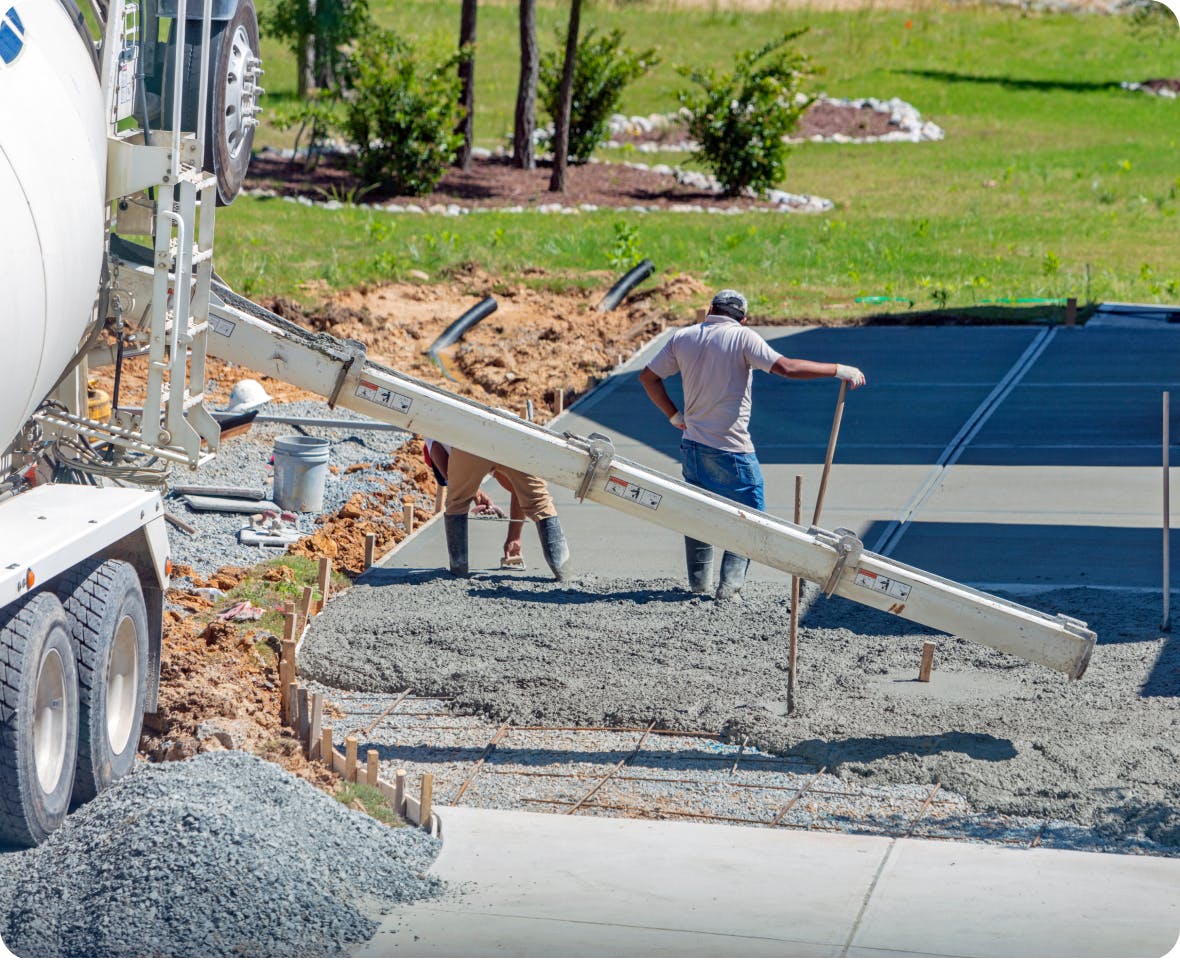Free Template: How to Estimate Concrete Work
Build a solid foundation for your concrete contracting business with our concrete estimate template and guide.

Concrete work is a key part of most home construction projects whether you are pouring a foundation, walls, sidewalks, stairways or swimming pools. Knowing how much to charge for projects is key to winning jobs and ensuring your business is successful. In this guide, we walk you through the steps of how to create a concrete estimate. We also include a free, downloadable, editable concrete estimate template to get you started.
Click on a link below to jump to the section you’re most interested in:
- Download our free concrete estimate template
- What is a concrete estimate?
- Why are concrete estimates important?
- When do you send a concrete estimate?
- What should be included in a concrete estimate?
- Optional sections to include in a concrete estimate
- How to create a concrete estimate step-by-step
- Alternatives to printable concrete estimate templates
- Final concrete estimating tips
Download our Free Concrete Estimate Template

Here's a Concrete Estimate Template on Us!
Customize this Concrete Estimate Template to secure your next job.
Concrete jobs include many variables that can impact the cost of the project, and having the right tools to draft a concrete cost estimate helps assure you don’t miss anything.
Our free concrete estimate template is a great way to get started because it serves as a guide of what should be included in a concrete work estimate template. The template is customizable and simple to tailor to your specific needs. It is downloadable for you to print and email to clients and includes a concrete estimate example to serve as inspiration.

In the long run, many construction professionals find that using concrete estimating software as part of an all-in-one management software further simplifies drafting professional-looking estimates and helps them run their businesses more efficiently. Try a free trial of Houzz Pro and explore our other templates for concrete contractors.

What is a Concrete Estimate?
A concrete estimate provides you and your customer an idea of how much the labor and materials will cost for a project, and also accounts for overhead costs and a profit margin. An estimate is typically followed up with a more exact quote that becomes the basis for the project once it is signed off by all parties. The term estimate is often used interchangeably with a quote, bid or proposal, but there are key differences.
A quote is legally binding while an estimate typically is not. An estimate differs from a formal bid which is more detailed and exact for jobs that require a bidding process. A proposal, which includes information about the past a concrete construction company has completed, is even more detailed than an estimate or quote.

Why are Concrete Estimates Important?
Besides helping clients understand how the project matches their budget, a concrete estimate helps construction pros know how much they need to charge for the job and still earn a profit to help their business grow and thrive.
Many factors influence the total costs outlined in a concrete work estimate template. Here are some common ones:
- Surface Prep Consider what type of equipment and the amount of labor it will take to excavate and level the site in preparation for pouring the concrete
- Formwork Using the building plans, determine how much formwork is needed to frame a concrete slab or other projects.
- Reinforcing Materials What materials are needed to increase the tensile strength of the concrete to resist cracking and breaking? Rebar is required beyond a certain thickness, and since there are various types of rebar, your choice will impact the overall cost of the project.
- Finish Work Consider the finish type required and the tools and labor that will be needed to accomplish it. A stamped finish, for example, will be more time consuming and costly than a basic broom finish.
- Slab Thickness The cost of a slab 4 inches thick versus 6 inches thick, for example, significantly impacts the amount of concrete required as well as the reinforcements needed.
- Quality of Concrete Determine what type of concrete you need for the job. The quality of concrete depends on the type and quality of minerals that are in it. Higher quality concrete includes more minerals which increase its strength and its cost.
- Site Conditions The current status of a site also affects the amount of prep work, leveling and access. Sites with terrain that is more difficult to navigate can add to equipment and labor costs.
- Job Location While most projects use ready mix concrete, this may not be the case for larger, or more remote job sites. In those cases, you will need to figure in the cost, equipment and materials for mixing the concrete on site such as sand and water ratio. Also, for all types of jobs, consider the transportation costs to and from the job.
- Job Size Of course, larger jobs take more materials and time to complete. Where you get your materials will also matter. Purchasing bags of concrete can work for small jobs, but for larger jobs it is easier to complete them if you purchase ready mix concrete by the yard instead of preparing bag after bag.

When Do You Send a Concrete Estimate?
An estimate for a concrete project is usually used in the early stages of a project to give a client an idea of the cost. It is typically not binding and works well when a customer has yet to commit to a project, but wants to know approximately what a job will cost. This helps set expectations for them, and also helps the construction Pro gauge how interested the client is in the job before spending too much work on drafting a more formal proposal.
If the customer agrees to go forward, you can then provide a binding, more specific quote, proposal or bid.

What should be Included in a Concrete Estimate Template?
There are some common elements included in every concrete estimate template. Here are the items you will likely add to every concrete cost estimate:
- Company Information Brand your estimate with your business name, logo and other pertinent information. Include the details for the person on your team who will be in the point person so the customer can easily contact them.
- Client Details Include the name and contact information for the customer, and how to reach the main contact person for the project.
- Estimate Number & Date You want to be able to easily locate the estimate and track it through the process. Create a unique number for every estimate and date the document. Adding a date also helps if you set a time limit, such as 30 days, for when the estimated prices expire, and need to be revisited.
- Table of Labor & Materials Make it as easy as possible for customers to understand the cost behind the project. List the quantity and cost of each category of materials. Also add the number of labor hours, hourly rates, and type of workers needed to complete the project.
- Summary of Costs Provide a recap of the labor and material costs as well overhead expenses and the profit margin included in the estimate.
- Acceptance & Signature End with a space for all parties to sign and date the concrete cost estimate.

Optional Sections to Include in a Concrete Estimate Template
- Scope of Work For projects that are big or complex, including a summary of the scope of work involved in the job can help signal to a customer that you understand their expectations and vision for the project. This can also help assure that everyone is on the same page regarding what is included and what is not.
- Discounts If you provide discounts include them here, and explain how customers can take advantage of them.
- Terms & Conditions This can be a place to add payment schedules, change order policies and the expiration date for an estimate.
- Additional Notes Is there anything about this project that requires special considerations. Is there anything unusual about this job compared to your more standard ones? If so, account for those.

How to Create a Concrete Estimate Step-by-Step
Now that you know what should be included in a concrete estimate, here’s a guide for finding that information, calculating costs and drafting your estimate:
1. Choose an estimate template or tool The first step is to decide between a template or estimating software to get started. Yes, you can use a piece of paper or blank document online, but with guiding tools readily available, chances are your competitors are using one of them to create more professional estimates faster.
A concrete estimate template provides a guide to what should be included in a concrete estimate. Make sure the template is easy to edit and customize, can be used in Word and Excel, and is fully downloadable so you can print it and send it. Even more efficient is a concrete estimating software such as Houzz Pro.
2. Review Plans Go over the plans to make sure you have a full understanding of the scope of the work involved so that you do not underestimate or overestimate the labor and materials needed, or overlook any other aspects of the job. Seek out information from the clients and visit the site if needed to fill in the blanks. Note anything that is unusual about this project compared to others you have completed.
3. Conduct Takeoffs Determine measurements, quantities and other information needed to calculate the timeline, materials and labor.
4. Estimate Material Costs Calculate the material costs using the takeoff measurements to determine the quantity you will need for each type of material:
- Ready-Pour Concrete Your measurements will determine the volume of concrete you will need. You can purchase bags for smaller jobs, but for larger projects, you will want to work with a supplier who will provide cost estimates for already mixed concrete by the yard based on the quantity, the quality control requirements, needed strength, and more.
- Rebar Many projects require rebar reinforcing bars. Know the building codes and determine what type of rebar will be needed for the job such as epoxy covered, sheet metal, and welded wire fabric. Prices will vary on the type.
- Equipment The costs of a concrete job includes more than just the materials. Calculate the cost of equipment and who will supply it. This includes wheelbarrows, mixers, digging bars, edgers and polishers. For larger or more remote projects, consider the costs of on-site mixing trucks.
5. Estimate Labor Costs
With the cost of the materials determined, now you will need to calculate how long it will take to complete the project, the types of labor needed for the job, and how much they will be paid.
The hours for labor need to be figured in for all of these aspects of the job:
- Mixing Determine the cost it will take to transport the mixed concrete to the on site mixer.
- Transportation How much will it cost to transport the mixed concrete to the site?
- Reinforcement This is the cost of cutting and tying rebars and any other reinforcement.
- Compaction Figure in the amount of time it takes to compact and smooth out the concrete with compactors and vibrators.
- Formwork How long will it take to install the formwork of beams, columns or slabs?
- Skilled Labor The number of workers needed to mix, compact, transport and finish the concrete.
Here are some other considerations for determining the cost of labor
- Shift Differentials Fold into your average labor costs the extra amount you may need to pay workers for less desirable shifts to keep your project on track.
- Overtime Do you anticipate any overtime costs? This could occur in projects that are more remote and take longer to reach. Or, perhaps you are trying to fit the pouring of the concrete into a limited weather window and need to complete it beyond the standard working hours.
- Skills Required Consider the type of skills that will be needed for the job and the availability of that labor within the region to help determine the average rate you will need to pay.
- Productivity Calculate how much a work an employee can carry out in a day to help determine your labor costs. Research the square footage or cubic yards an average concrete worker can cover in a day, not the extraordinary worker who exceeds the averages.
Additional Steps:
6. Factor in Overhead It costs money to run a business and those expenses need to be accounted for to keep your company profitable. Calculate fixed costs such as rent, vehicles, computer equipment, insurance, and more to come up with the annual or monthly total and factor it into your estimate. Prorate the amount to match the length of time the project is expected to take.
7. Determine Profit Margin What percentage do you need to include to assure that you are earning a profit, and reinvesting in the growth of your business? Determine this percentage and prorate it as part of your markup costs.
8. Calculate Total Costs Add all the costs together to reach your total.
9. Seek a Second Opinion Ask someone you trust to review the estimate before you submit it. This can help avoid costly mistakes.
10. Review & Send Review your concrete cost estimate one more time, and hit the send button.
11. Track Feedback Make sure you have a process for following up, and recording any feedback and approvals.

Alternatives to Printable Concrete Estimate Templates
Using a management software like Houzz Pro that is tailor made for concrete contractors can help you create estimates more quickly and run your business more efficiently. The takeoff tool is built into the concrete estimating software as well as price lists for your region. Then, once the job is underway, Houzz Pro helps you manage the project from start to finish, and makes it easy to get paid for your work.
If you’re worried about ramp up time with a software–don’t! You can simply copy and paste information from our free concrete estimate Excel template (or any other spreadsheet for that matter) to import it into Houzz Pro with one click.

Final Concrete Estimating Tips
- Understand the Job Scope Make sure you have accounted for the full magnitude and complexities of the project before you begin. Consider the required strength, type of concrete, color and any special curing that might be needed. Cost overruns can lead to uncomfortable conversations with your customer, or worse yet end up coming out of your pocket.
- Include a Buffer While you do not want to end with a huge amount of waste at the end of the job, avoid coming up short. Build in a margin of safety and order slightly more cubic yards than you need.
- Don’t Overlook Overhead Value your cost of doing business and needed profit margin to assure that you are earning the money you deserve and need to grow your business.
- Include Related Services Make sure you’ve covered essential services in your estimate that go beyond the actual concrete project whether it is water supply, ground prep or more.
- Check Your Competitors Find out how your estimates match up with competing companies in your region offering the same services. This will help you gauge if you are overcharging, or under selling yourself in your market.
- Adjust Over Time As markets change, and you learn more about estimating, turn the lessons into action. Make adjustments as you go along to make your concrete estimates the best in class.
Conclusion
Making a concrete cost estimate is not as straightforward as it may appear at first glance. Honing estimation skills takes research and practice. The job is easier when you have the right tools at hand to draft professional, accurate estimates as quickly as customers expect them.
Start with our concrete estimate sample above and our guide on how to estimate concrete work to get your business off the ground. When you’re ready to take your business to the next level, concrete takeoffs software does the heavy lifting for contractors. Explore Houzz Pro concrete takeoff software today.

Want advice delivered to your inbox?
Unlock industry insights and updates for contractors and design pros
By signing up, I agree to the Houzz Terms of Use and Privacy Policy and that Houzz may use my information to contact me about relevant content, products, and services.








Join the conversation by commenting or asking a question below. The Houzz team reads every single comment, and we’ll get back to you by email if you need us!